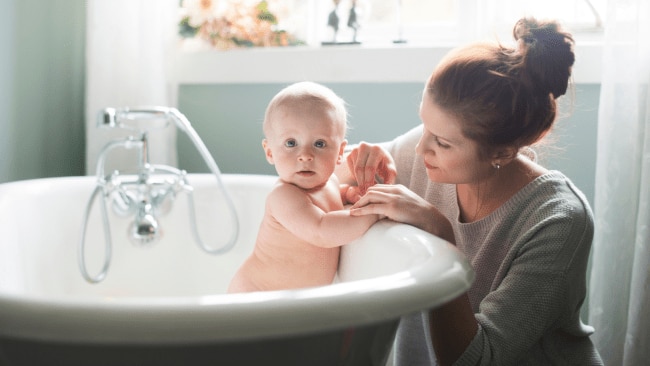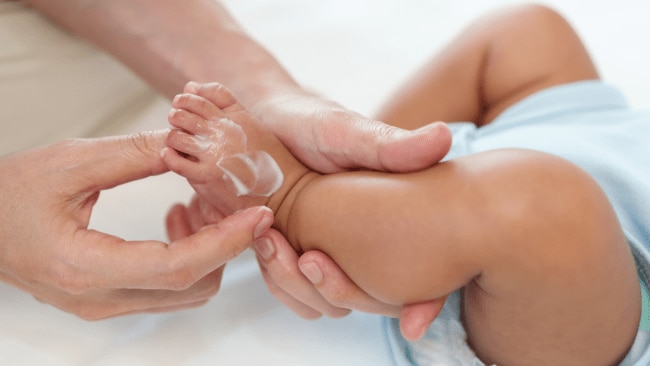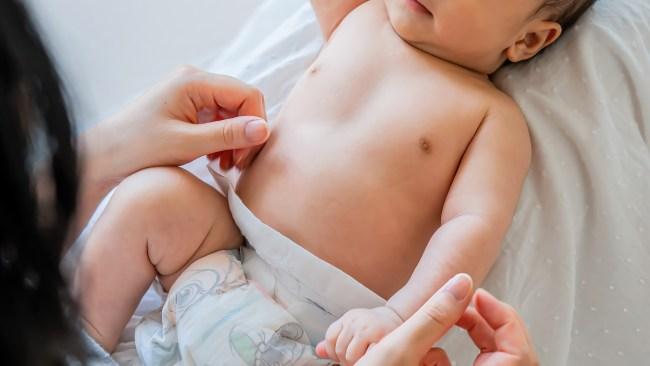I'm a midwife, here are five things you need to know about your newborn's skin
Kidspot chatted to Jane Barry, registered nurse, midwife and child health nurse who you could say has ‘skin in the game’...
Baby
Don't miss out on the headlines from Baby. Followed categories will be added to My News.
If you’re reading this, you’ve likely just welcomed your little bundle of joy into the world or you’re about to. Either way, GO YOU!
Now, you’re likely trawling through an overwhelming amount of information about how to care for your little one, especially for their delicate and sensitive skin.
From nappy rash to Eczema, to hives and baby acne - there’s a lot to learn.
Your thumb is probably hurting from all the scrolling (apparently, new parents make up to 2000 Google searches in the first year) and your mum is on speed dial to help you with those niggly-but-oh-so-necessary questions the internet just can’t seem to answer.
It can feel impossible to separate fact from fiction and pull out only the most important stuff you actually need to know.
But don’t worry, we’ve got you covered.
Want to join the family? Sign up to our Kidspot newsletter for more stories like this.

RELATED: Huggies launches exciting new nappy range
"Babies' skin is thinner, more sensitive and fragile"
Kidspot chatted to Jane Barry, a registered nurse, midwife and child health nurse who specialises in… you guessed it, babies! Some would say she has ‘skin in the game’...
First things first, Jane tells us that newborn skin is different to adult skin in the first few months of life as theirs is still very much developing.
“Babies' skin is thinner, more sensitive and fragile. Their skin also feels smoother and softer than an adult’s,” she says. “This is because of the thinner upper skin layer which is less protective than it will be as they mature. Baby skin is also less resistant to bacteria and easily reacts to products which may penetrate their skin, causing it to become irritated.”
So now we know it’s sensitive AF, we asked Jane about five things we need to know about caring for our newborn’s skin.
RELATED: What you need to know about caring for your newborn baby's skin
What are some common skin issues you might see in newborns?
“It’s common to see newborns with skin irritation and rashes. Reassuringly, most are not serious and get better without any special treatment,” Jane says.
Here are some of the most common skin issues:
Milia - is caused by blocked oil glands. These look like small white spots on the baby’s nose and face. Milia don’t cause any itching, aren’t contagious and generally clear up in a few weeks.
Erythema toxicum – Often appears in the early weeks of life. This is a common skin condition that causes flat red patches or small bumps, first on the face and then on the body and limbs. This is another skin reaction that is harmless and generally clears up after a few days or a week.
Baby acne – Looks like adolescent or adult acne with red spots and pimples on the face, mostly the nose and cheeks. Although baby acne can look uncomfortable, it generally doesn’t seem to bother them. Again, there’s no special treatment. It’s important not to pick or squeeze at the spots. Doing this can cause infection and scarring.
Nappy rash – is a type of skin inflammation in the nappy area. It’s caused by wee and/or poo irritating the skin and creating a red, inflamed and sore-looking rash. Most nappy rash improves with more frequent nappy changing - at least every couple of hours and more often if they’re weeing and pooing a lot, cleaning the skin thoroughly and applying a barrier cream. Sometimes nappy rash is caused by a fungal or bacterial infection which both require a specific type of nappy rash cream, containing either antifungal or antibacterial medication.
Hives – In most cases, hives are due to a viral infection. But they can also be caused by an allergic reaction to foods and even some medications. If hives are caused by an allergy, the treatment is to avoid the trigger. Antihistamine medications can be prescribed by a doctor to ease the symptoms of hives.
Eczema – is a common skin condition that causes the skin to become itchy, red, dry and cracked. It’s the most common skin condition affecting babies and children. Eczema is most often seen in the knee and elbow creases. Babies aged less than 12 months are often affected by eczema. The key to managing eczema is to avoid using products and clothing which irritate the baby’s skin and to moisturise their skin regularly. Creams are generally more effective than lotions because they’re thicker and are more moisturising. Sometimes steroid cream is needed to reduce the skin inflammation and ease the itching.
Prickly heat – is more common in hot and humid weather. Tiny red bumps or blisters appear on the baby’s skin which can cause itching and irritation. Prickly heat can be eased by cool baths and avoiding excess heat. The rash caused by prickly heat usually clears in a couple of days.

How should parents look after their newborn’s skin while bathing them? Any specific precautions to keep in mind?
According to Jane, each time you bathe your baby, you should check their skin for any rashes and irritation.
“When they’re naked is a perfect time to really have a good look at what’s going on with their skin. Because baby skin is so sensitive, rashes can appear very quickly. But with the right care, rashes can also clear up quickly.”
The key here is to use mild, gentle products when bathing your baby.
“Soap-free cleansers which are fragrance-free and don’t contain any antibacterial agents will help to avoid skin irritation,” says Jane. “Use a cleanser which is hypoallergenic and pH neutral, with a pH of 5.5.
“Also make sure to check the temperature of the bath water with your inner wrist – it should feel comfortably warm and not hot. Use a soft clean washer to clean your baby’s skin and a soft towel to pat, rather than rub their skin dry.”

What about moisturising? What type is best type and are there any ingredients you should avoid?
When it comes to moisturising your baby, Jane says there’s so much choice, with each product claiming to be the ‘perfect’ one. “But the truth is that often the simplest, least fancy moisturisers are the best.”
“Aqueous cream, Sorbolene or paraffin are fine as they’re all free from fragrances and plant extracts,” explains Jane. “Ideally, moisturise your baby’s skin after their bath when their skin is still warm and the pores are open, or a couple of times each day if their skin looks dry or flaky. Be careful that the moisturiser doesn’t become contaminated by ‘double dipping’ your fingers into the tub. Instead, use a spatula or spoon to get out what you need, or use a pump pack which dispenses controlled amounts.”
Smart!

Alright, you mentioned the dreaded nappy rash earlier. What are some tips for parents to help create a happy nappy region?
Like with many other skin concerns, Jane says prevention is key here.
“It’s easier to avoid nappy rash in the first place than treat it once it’s present. Because a baby’s nappy area is constantly exposed, moisture and rubbing, skin damage and nappy rash are common,” Jane says.
But the good news is that there are lots of things you can do to help avoid this from happening.
“Change your baby’s nappy frequently and make sure to use good quality disposable nappies. It’s important that any moisture is drawn away from the baby’s skin – this will help to keep their skin dry,” Jane says.
“You may need to also use a pH-neutral soap or soap-free cleanser on their skin to remove any wee or poo. Apply a barrier cream that contains zinc in a thick layer if their skin is red or you think they need it.
“Sometimes it helps to warm thicker creams by rubbing between the fingers before smearing on the skin. Avoid using talcum powder which can block the skin’s pores and cake in their creases.”
Finally, she says to, “Give your baby some nappy free time each day to kick freely and for their skin to breathe.”

Are there any special considerations or tips for caring for the umbilical cord stump and preventing infection?
“Speak with your midwife to see if you need to do anything special to care for your baby’s cord stump. Generally, it’s enough to simply keep the stump clean and dry. Wash your hands each time before touching their cord area. Clean around the base using plain water and cotton buds,” says Jane.
“You could also use a pH-neutral cleanser when you bath them. Don’t use antiseptic or alcohol wipes, because this will delay the time it takes for the cord stump to separate. Try to expose the cord to air as much as possible and fold down your baby’s nappy so it’s not covering the cord.
“If you notice any smell, redness or discharge from your baby’s cord area, see your GP as soon as possible. Cord separation generally happens within 7-10 days after birth.”
Jane then adds this important reminder for parents, “See your GP, paediatrician or Child Health Nurse if you’re worried about your baby’s skin. Although most rashes and skin irritations clear up quickly without any doing anything special, sometimes more support or treatment is needed.”
So there you have it! Five tips to ensure your bub’s delicate skin stays as smooth as… their own bottom!
The new HUGGIES® Newborn and Infant nappies are available now at participating retailers across the country from RRP $22 for bulk packs.
Originally published as I'm a midwife, here are five things you need to know about your newborn's skin



